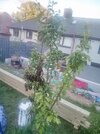Hi guys,
I have a Beth pear tree that is five years old. It's never fruited but does flower. According to an app on my phone it has brown spot.
Can anyone give some advice please if I should take the whole branch off or something else?
I use a liquid fertiliser and water it weekly. It has other pollinators nearby which all seem healthy.
Cheers Larry
I have a Beth pear tree that is five years old. It's never fruited but does flower. According to an app on my phone it has brown spot.
Can anyone give some advice please if I should take the whole branch off or something else?
I use a liquid fertiliser and water it weekly. It has other pollinators nearby which all seem healthy.
Cheers Larry



